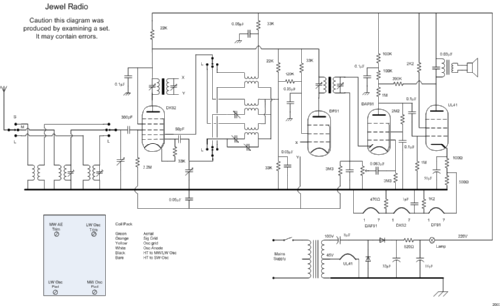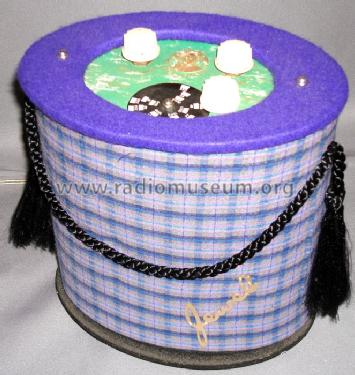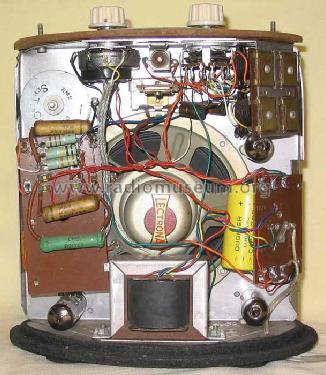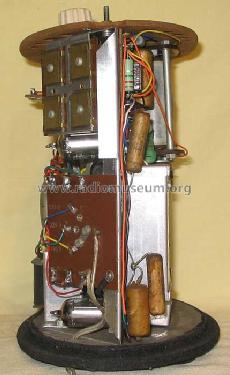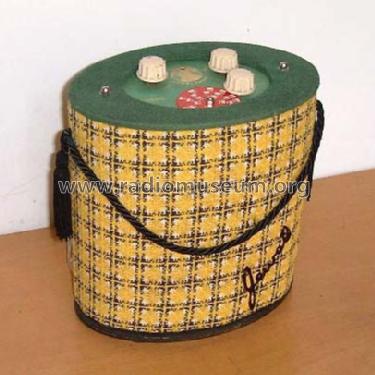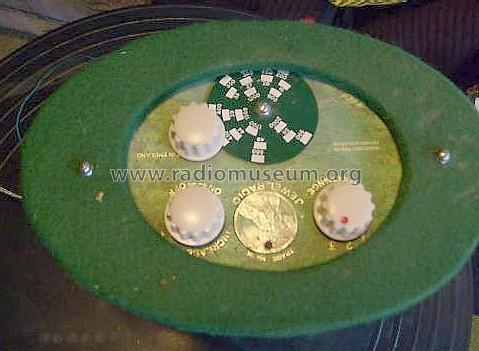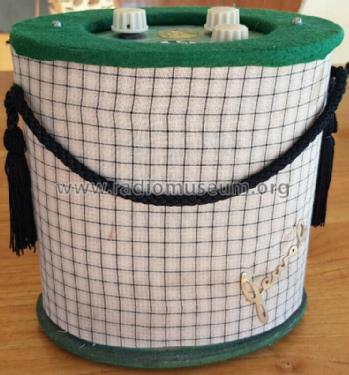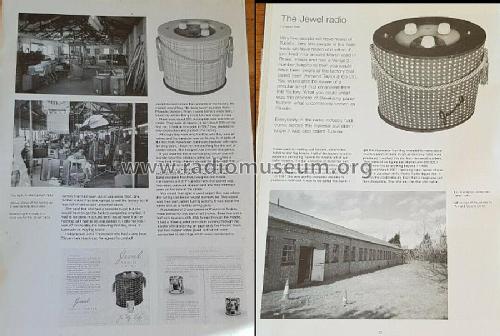Jewel
Jewel Radio, Basildon
- Land
- Grossbritannien (UK)
- Hersteller / Marke
- Jewel Radio, Basildon
- Jahr
- 1957
- Kategorie
- Rundfunkempfänger (Radio - oder Tuner nach WW2)
- Radiomuseum.org ID
- 79437
Klicken Sie auf den Schaltplanausschnitt, um diesen kostenlos als Dokument anzufordern.
- Anzahl Röhren
- 4
- Hauptprinzip
- Superhet allgemein
- Wellenbereiche
- Langwelle, Mittelwelle und Kurzwelle.
- Betriebsart / Volt
- Wechselstromspeisung / 110; 225; 245 Volt
- Lautsprecher
- Dynamischer LS, keine Erregerspule (permanentdynamisch)
- Material
- Leder / Stoff / Plastic / Segeltuch über div. Material
- von Radiomuseum.org
- Modell: Jewel - Jewel Radio, Basildon
- Form
- Diverse Formen, unter Bemerkung beschrieben.
- Abmessungen (BHT)
- 8 x 9 x 5.25 inch / 203 x 229 x 133 mm
- Bemerkung
- Oval fabric-covered fibre case. Available in 25 colour combinations. An optional external converter (12 volt) was available for use in a car. Cost £5. This set uses an unusual tuning capacitor. A copper foil is wound onto a drum as the tuning knob is rotated. Causing a change in value of capacity.
- Nettogewicht
- 2.2 kg / 4 lb 13.5 oz (4.846 lb)
- Originalpreis
- 15.00 GBP
- Datenherkunft
- Radio! Radio!
- Literaturnachweis
- Bulletin of the British Vintage Wireless Society (BVWS, 73) (BVWS Bulletin Vol 27 Number 2)
- Literatur/Schema (1)
- Autor
- Modellseite von Konrad Birkner † 12.08.2014 angelegt. Siehe bei "Änderungsvorschlag" für weitere Mitarbeit.
- Weitere Modelle
-
Hier finden Sie 1 Modelle, davon 1 mit Bildern und 1 mit Schaltbildern.
Alle gelisteten Radios usw. von Jewel Radio, Basildon
Sammlungen
Das Modell Jewel befindet sich in den Sammlungen folgender Mitglieder.
Forumsbeiträge zum Modell: Jewel Radio,: Jewel
Threads: 1 | Posts: 2
BVWS Bulletin Vol 27, Number 2. Has an article by Gerald Wells which gives some interesting information about the Jewel Company & radio set. For those that do not have access to this bulletin I have summarised the key points.
The company was created in 1957 by a parent company ARMOND TAYLOR, manufacturers of paxolin products. Jewel Radio started production of its first model the “Jewel”. However this set was not successful & the factory closed suddenly during the first year. It is thought that approximately 1000 sets were produced, with a failure at of 20%.
In March 2001 the factory was sold, but it still contained the production equipment & sets as left when the doors were closed in 1957. The owner contacted Gerald Wells of the Vintage Radio Museum (Dulwich, London, UK), & offered the contents to the Museum. Approximately 200 sets (all the rejects) & some partially built sets were recovered. These sets were repaired by the museum & have been distributed or sold.
The set is very unusual not only in its appearance but also how it works. It uses a UL41 (normally for AC/DC sets) & 3 battery valves (1.4v 50mA). The heater of the UL41 is supplied by a mains transformer, a cathode resistor creates a bias voltage. This voltage is used to feed the heaters of the 3 remaining battery valves. Another unusual feature is the tuning capacitor, it has no rigid plates. A strip of flexible copper is wound onto an insulated metal drum as the tuning knob is turned. This strip has capacity with the drum, the value dependant on the amount of strip wound against the drum. It is perhaps no wonder so many sets were rejects, but it does provide a wonderful curiosity for collectors.
Keith Staines, 15.Jul.07
